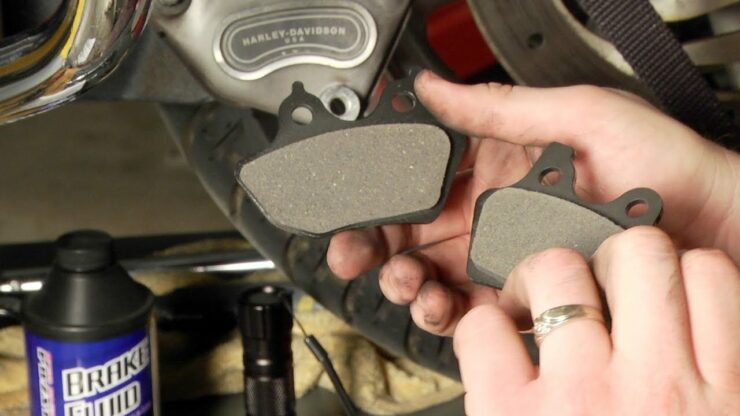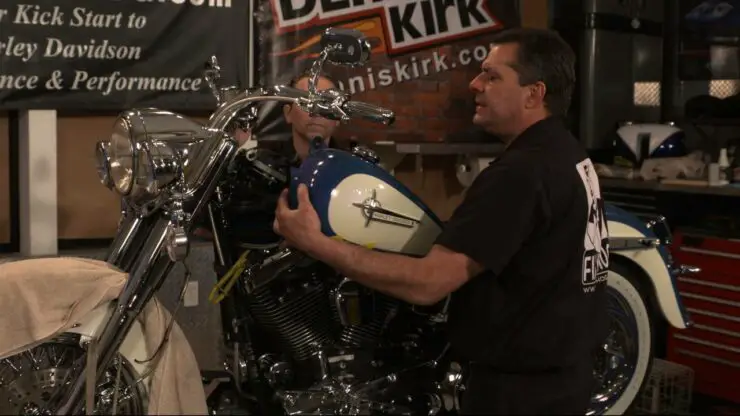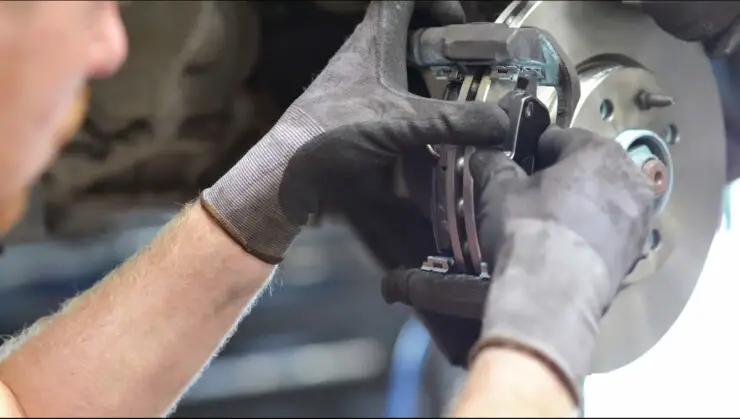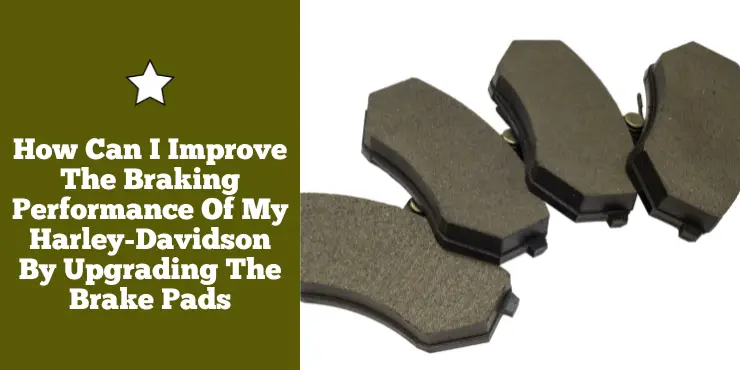If you’re a proud Harley-Davidson owner, you know that the exhilaration of riding on the open road is unmatched. However, when it comes to ensuring your safety and maximizing the performance of your beloved Harley, one area that often gets overlooked is the braking system. If you’ve ever found yourself wishing for better braking power or a more responsive feel, then it’s time to consider upgrading your brake pads.
Upgrade to sintered or ceramic brake pads for improved braking performance on a Harley-Davidson. These materials offer better heat dissipation, durability, and stopping power compared to standard organic pads.
In this article, we will explore the various ways you can improve the braking performance of your Harley-Davidson by simply swapping out your brake pads. Get ready to dive deep into the world of brake pad upgrades, where we’ll uncover the secrets to unlocking enhanced stopping power and a smoother ride.
How can I improve the braking performance of my Harley-Davidson by upgrading the brake pads?
Riding a Harley-Davidson bike is all about experiencing the open road, the freedom, and the undeniable allure of a legend on two wheels. While the Harley-Davidson name is synonymous with style and power, it is equally important to prioritize safety and control. One of the key aspects of safety on the road will be the performance of your braking system. At the heart of the braking system will be brake pads.
>>> Click here to read our review of the Best Break Pads For Harley-Davidson <<<
Brake pads are essential components of a motorcycle’s braking system. They are positioned on both sides of the brake discs (also known as rotors) and act as the friction material that generates the stopping force when you engage the brakes. Brake pads consist of composite materials designed to withstand high levels of heat, friction, and pressure. As you’re applying the brake lever or pedal, the brake pads clamp onto the spinning brake discs, creating the needed friction to slow down or stop the bike.
The ability to bring your bike to a controlled stop will be paramount to your safety, the safety of your passengers, and the safety of other riders on the road. Proper braking performance will ensure that you can confidently navigate traffic, negotiate sharp turns, and react to sudden hazards. However, sometimes you might wonder how can I improve the braking performance of my Harley-Davidson by upgrading the brake pads. Upgrading the brake pads is a strategic move as you’ll be able to maximize the safety and control of your bike.
Here is how upgraded brake pads improve the braking performance of your Harley-Davidson bike –
#1. Enhanced friction material
One of the key aspects of upgraded brake pads will be the use of advanced friction materials. These materials are specifically engineered to offer superior friction and stopping power. This results in a more effective and responsive braking system.
#2. Improved heat resistance
During the braking process, a tremendous amount of heat will be generated. Upgraded brake pads are designed to withstand higher temperatures and maintain their effectiveness under extreme conditions. This heat resistance will mean your brakes will perform consistently, even during aggressive riding or in hilly terrains.
#3. Reduced fade
Brake fade occurs when the braking system’s performance diminishes due to overheating. Upgraded brake pads are less prone to fade, allowing you to maintain strong and consistent braking even during prolonged or heavy use.

#4. Faster response
Upgraded brake pads offer faster response times, reducing the distance it takes to come to a stop. This improved responsiveness will enhance your ability to react to sudden obstacles or changing traffic conditions, ultimately improving your safety.
#5. Reduced noise and vibration
Upgraded brake pads are often designed for smoother and quieter operation. Lesser-quality brake pads can produce unwanted noise and vibrations when applied. Quality pads minimize these disturbances, ensuring you get a more enjoyable and comfortable ride.
#6. Longevity
Quality upgraded brake pads are engineered for longevity and durability. They tend to last longer, reducing the frequency of brake pad replacements and the associated maintenance costs.
#7. Optimal control
The improved braking performance and responsiveness of upgraded brake pads will contribute to better control over your Harley-Davidson bike. Whether you are cruising on the highway, navigating winding roads, or making sudden stops, upgraded brake pads will provide the control you need.
Different types of brake pads in Harley-Davidson bikes
Harley-Davidson bikes are more than just a means of transportation. These bikes are an embodiment of power, style, and freedom. Ensuring the safety and control of your bike will be important for the overall experience. Brake pads play a key role in the braking system of your bike. These small but crucial components are important for slowing down and stopping your bike effectively. Here are the different types of brake pads available for Harley-Davidson bikes –
Organic brake pads
Organic brake pads, also known as Non-Asbestos Organic (NAO) brake pads are composed of organic materials like rubber, carbon, glass, and other resins. They’re known for their smooth and quiet operation, making them a great choice among riders who value comfort and reduced noise. They offer impressive initial bite, which means they respond quickly when you apply the brakes. Organic brake pads are gentle on brake discs, reducing wear and tear. However, they might wear down faster than some other types, especially under heavy use.
Semi-metallic brake pads
Semi-metallic brake pads are made with a mixture of organic materials and metal fibers, usually steel. These brake pads offer a balance between performance and longevity. They have amazing heat dissipation properties, which makes them ideal for high-performance or heavy-duty riding. Semi-metallic brake pads offer strong stopping power and are less prone to brake fade compared to organic pads. They can be noisier and generate more dust, which might require more frequent cleaning.
Ceramic brake pads
Ceramic brake pads are composed of a fusion of ceramic fibers, non-ferrous materials, and bonding agents. They’re known for their excellent heat resistance, making them a preferred option for riders who engage in high-speed or aggressive riding.
Ceramic brake pads offer consistent performance in different weather conditions and create less dust compared to semi-metallic pads. They are quieter and gentler on brake discs, reducing wear and tear. However, they tend to be more expensive compared to other types.
Sintered brake pads
Sintered brake pads are constructed from metal particles fused together under high pressure and heat. These pads are often used in high-performance applications like racing or off-road riding due to their exceptional durability and heat resistance. Sintered brake pads can handle heavy loads and offer excellent stopping power even in extreme conditions. They’re less likely to experience brake fade, making them perfect for demanding riding scenarios. However, they can get noisy and might generate more dust than other types.
Carbon fiber brake pads
Carbon fiber brake pads are made from a combination of carbon particles and resins. These brake pads are a high-performance option known for their lightweight nature and excellent heat resistance.
Carbon fiber brake pads offer strong and consistent stopping power, making them ideal for both everyday riding and high-speed applications. They generate minimal dust and are known for their longevity. However, they tend to be more expensive than other types.
Factors to consider when upgrading Harley-Davidson brake pads
As you’re looking to improve the riding experience on your Harley-Davidson bike, it is important that you consider every element that contributes to control, performance, and safety. Upgrading the brake pads is one such consideration that demands a lot of careful evaluation. Here are some of the factors you must consider when upgrading the brake pads in your Harley-Davidson bike.
#1. Assess your style and preferences
Every Harley-Davidson rider is unique, with distinct riding styles and personal preferences. Your choice of brake pads needs to align with your individual characteristics and desires. You must consider whether you are a cruiser, a performance enthusiast, or someone in between. If you enjoy leisurely rides and casual cruising, you could prioritize comfort and reduced noise. Conversely, if you are an aggressive rider or often navigate challenging terrains, you might lean towards high-performance brake pads.
Determine whether you value a quieter and more comfortable ride or prioritize high-performance brakes that offer superior stopping power. Brake pads vary in terms of responsiveness and noise levels, so make your choice according to your preference.
Consider your budget when you’re selecting brake pads. While high-performance options might come at a premium, there are choices for different budgets. It is important to strike a balance between your preferences and financial constraints.
#2. Understand the specific braking requirements of your bike
Every Harley-Davidson bike has its unique characteristics and requirements. To choose the right brake pads, you must know the specific braking requirements of your bike. Your bike’s owner’s manual is a valuable resource for understanding the manufacturer’s recommendations for brake pad types. Harley-Davidson offers guidelines on the type of brake pads that work well with your bike.
Heavier and more powerful Harley-Davidson bikes might require brake pads with superior stopping power to effectively slow down your bike. Meanwhile, lighter models might not demand as much from the brake system.
If you have made any upgrades or modifications to your bike, such as engine enhancements or changing tire sizes, your braking requirements might have changed. Assess the impact of these changes on your motorcycle’s braking performance.
#3. Evaluate the current condition of your bike’s braking system
Before you upgrade your brake pads, it’ll be important to assess the condition of your current braking system. Examine your existing brake pads for wear and tear. If they are significantly worn, it is a sign that they need replacement. Uneven wear patterns can suggest issues with other components like rotors or calipers.
Check the condition of the brake calipers and rotors. If there is any visible damage or excessive wear, it might indicate the need for additional maintenance or replacement.
You should also consider the quality of your brake fluid. Brake fluid needs to be clean and free from any contaminants. If it is discolored or contaminated, it is advised that you should get it replaced. Proper brake fluid will be important for optimal braking performance.
If you aren’t sure about the condition of your braking system, you should consider having it professionally inspected or undergoing a brake system bleeding. This process will ensure that any air bubbles or contaminants are removed from the hydraulic system, improving brake performance.
How to choose the right brake pads for your Harley-Davidson bike?
When it comes to Harley-Davidson bikes, a key aspect of maintaining and even enhancing the safety and performance of these bikes would be choosing the right brake pads. With such a variety of options available, selecting the best possible brake pads for your Harley-Davidson bike can be a daunting task. Here are some of the tips you must keep in mind to select the right brake pads for your Harley-Davidson bike.

#1. Research reputable brake pad brands
The first thing to do when you’re looking to upgrade your brake pads would be to research reputable brake pad brands. Look for manufacturers that have a track record of producing high-quality products. Harley-Davidson riders are known for their discerning tastes, so you will want to choose a brand that has earned the trust of riders. Reputable brands are known for offering better quality control and reliable customer support.
#2. Compare different brake pad options based on material
Harley-Davidson riders can choose from different brake pad materials, each with its own set of characteristics. Organic brake pads are the commonly used options. Best known for their smooth and quiet operation, organic brake pads are suited for riders who prioritize comfort and reduced noise. They offer the initial “bite” needed for responsive braking but might wear out more quickly under heavy use.
Semi-metallic brake pads are a balance between performance and longevity. They have excellent heat dissipation properties, offering strong stopping power with less risk of brake fade. However, they could be noisier and generate more dust. Ceramic brake pads are highly celebrated for their heat resistance and consistent performance. They tend to be more expensive but they’re a great choice for both daily riding and high-performance applications.
Sintered brake pads are constructed from metal particles fused under high pressure and heat. These brake pads excel in durability and heat resistance, making them ideal for demanding riding conditions such as racing or off-road driving. They’re less likely to experience brake fade but can be noisier and produce more dust.
Composed of resins and carbon particles, Carbon fiber brake pads are lightweight and heat-resistant. They offer amazing stopping power and longevity while being gentle on brake discs. However, they are quite expensive.
#3. Evaluate brake pad performance
You should consider your specific riding requirements and the level of performance you need from the brake pads. If you are a cruiser who enjoys leisure rides, you should prioritize comfort and reduced noise over extreme stopping power.
However, if you engage in high-speed adventures or aggressive riding, you might need brake pads that offer superior performance and heat resistance to handle demanding conditions.
#4. Compare prices
Budget constraints will be a key decision when choosing the right brake pads for your Harley-Davidson bike. Compare the prices of brake pads from different manufacturers and types. While high-performance brake pads might come at a premium, there are different options available for various budgets. Make sure that you strike the right balance between your preferences and financial limitations.
#5. Seek recommendations from fellow riders
One of the most valuable sources of information will be advice from fellow riders. You should reach out to your motorcycle community, be it at a local club, social media group, or an online forum to ask for recommendations. Riders who have similar bike models and riding styles can offer insights into the best brake pads for your specific needs.
How to install new brake pads on your Harley-Davidson bike?
Upgrading the brake pads on your Harley-Davidson bike is a critical maintenance task that enhances safety and performance. Whether you are a novice enthusiast or a seasoned rider, installing new brake pads will be a great upgrade. However, you will need to know how to carry out the installation of new brake pads. Here are the steps you need to follow to install new brake pads on your Harley-Davidson bike.
Step 1: Prepare the necessary tools
Before you get started, you need to gather a list of tools and materials you will need –
- New brake pads – Ensure that you have the appropriate brake pads for your Harley-Davidson bike
- Motorcycle lift or stand – You will require a reliable motorcycle lift or stand to elevate your bike safely
- Socket set and wrenches – Various socket sizes and wrenches to remove bolts and fasteners
- Brake fluid – You may need brake fluid to top up the reservoir or bleed the brake system if needed
- Brake caliper tool – A caliper tool will help compress the caliper pistons when installing new brake pads
- Torque wrench – A torque wrench will help in accurate tightening of bolts and fasteners
- C-clamp or brake pad spreader – A tool to push the caliper pistons into the caliper housing
- Clean rags and brake cleaner – For cleaning brake components
Step 2: Jack up your bike and remove the wheels
Start by safely elevating your bike using a motorcycle lift or stand. Make sure that it is stable and secure. Use a socket set for removing the bolts securing the brake caliper to the mounting bracket.
Carefully slide the caliper off the brake disc and suspend it using a wire or bungee cord, ensuring that it doesn’t hang from the brake line and cause damage. With the caliper out of the way, you’ll be able to remove the wheel. Loosen the axle nut and then slide the axle out, allowing you to remove the wheel easily.

Step 3: Remove the old brake pads and inspect the brake components
With the wheel off, you will be able to access the old brake pads and inspect the brake components. Use a C-clamp or brake pad spreader to gently push the caliper pistons back into the caliper housing. This setup will be important for creating enough space for the thicker new brake pads. Once the pistons have been retracted, carefully remove the old brake pads from the caliper bracket.
While the old brake pads have been removed, take a moment or two to inspect the brake components. Check the condition of the brake rotors for any signs of wear, warping, or grooves. Moreover, inspect the caliper for any visible damage or fluid leaks. Make sure that all the components are in good condition for optimal braking performance.
Step 4: Install and bed in the new brake pads
Now comes the time to install the new brake pads and bed them in for optimal performance. Place the new brake pads in the caliper bracket, making sure that they are correctly oriented. Some brake pads might have indicators or markings that specify the top and bottom.
Slide the caliper back over the brake disc, aligning it with the new brake pads. Use a socket set to secure the caliper bolts to the manufacturer’s recommended torque specification.
Before you ride your bike, it’ll be important to bed in the new brake pads. This process will involve a series of controlled stops to transfer an even layer of friction material onto the brake disc. Follow the manufacturer’s recommendations for the specific bedding-in procedure for your brake pads. Typically, this will involve progressively increasing the braking force with several gentle stops, followed by a few aggressive stops.
FAQs
What are the benefits of upgrading the brake pads on my Harley-Davidson to improve braking performance?
Upgrading the brake pads on your Harley-Davidson can provide several benefits. Firstly, you can experience improved stopping power, allowing you to brake more efficiently and effectively. Secondly, upgrading the brake pads can enhance the overall safety of your ride by reducing the stopping distance. Lastly, high-performance brake pads can offer better durability and longevity, ensuring consistent performance over time.
Are there different types of brake pads available for my Harley-Davidson, and which ones should I choose for improved braking performance?
Yes, there are various types of brake pads available for your Harley-Davidson. Common options include organic, semi-metallic, and ceramic brake pads. Organic pads are suitable for everyday riding and offer a quieter and smoother braking experience. Semi-metallic pads provide increased stopping power and are ideal for high-performance riding. Ceramic pads, on the other hand, offer a longer lifespan, reduced noise, and improved heat dissipation. For improved braking performance, it is recommended to consider semi-metallic or ceramic brake pads based on your specific riding needs.
Can I upgrade the brake pads on my Harley-Davidson myself, or do I need professional assistance?
While it is possible to upgrade the brake pads on your Harley-Davidson yourself, it is generally recommended to seek professional assistance, especially if you are not experienced in motorcycle maintenance. Brake systems are critical for safety, and any mistakes during installation can have serious consequences. Professional mechanics have the necessary skills and tools to ensure proper installation, including proper brake pad alignment, proper torque settings, and appropriate bedding-in procedures. Investing in professional assistance can provide peace of mind and ensure optimal braking performance.
>>> Read more about Break Pads For Harley-Davidson <<<

